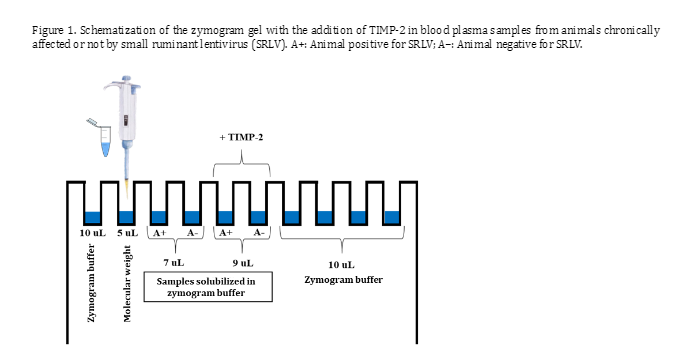Profile of extracellular matrix metalloproteinase in healthy and infected Toggenburg goats with small ruminant lentivirus in Southeast Brazil
DOI:
https://doi.org/10.21708/avb.2023.17.2.10972Resumo
Small ruminant lentiviruses (SRLV) are difficult to diagnose due to their escape mechanisms. Therefore, proteomics is an alternative in the search for biomarkers through extracellular matrix metalloproteinases (MMPs), enzymes related to the immune response. In this sense, this study aimed to analyze the profile of MMPs in healthy and infected Toggenburg goats with chronic SRLV infection in Southeast Brazil. Five positive and five negative goats for SRLV were selected using the agar gel immunodiffusion (AGID) microtechnique, western blot (WB), and nested polymerase chain reaction (nPCR). All animals were submitted to blood collection by puncture of the jugular vein, followed by centrifugation to obtain blood plasma, protein quantification by the Bradford method, one-dimensional electrophoretic separation (1D), and identification of protease activity by zymography and confirmation via reverse zymography in the presence of MMP-2 through the action of tissue inhibitors (TIMP-2). The analysis of protein bands was performed using descriptive statistics and densitometry values for zymography were subjected to the Shapiro-Wilk test to determine normality. Little difference was observed in the occurrence of protein bands between groups. Regarding MMPs, no differences were observed in the expression of proMMP-9, MMP-9, and MMP-2 in animals affected by SRLV. TIMP-2 inhibited proMMP-2 and MMP-2 in all animals. Thus, the profile of protein bands does not change in healthy goats with chronic SRLV infection. The TIMP-2 expression allowed proving the existence of MMP-2 in animals chronically infected by SRLV via reverse zymography.
Downloads

Downloads
Publicado
Edição
Seção
Licença
Copyright (c) 2023 Acta Veterinaria Brasilica

Este trabalho está licenciado sob uma licença Creative Commons Attribution 4.0 International License.
Autores que publicam na Acta Veterinaria Brasilica concordam com os seguintes termos: a) Autores mantém os direitos autorais e concedem à revista o direito de primeira publicação, com o trabalho simultaneamente licenciado sob a Licença Creative Commons Attribution que permite o compartilhamento do trabalho com reconhecimento da autoria e publicação inicial nesta revista. b) Autores têm autorização para assumir contratos adicionais separadamente, para distribuição não-exclusiva da versão do trabalho publicada nesta revista (ex.: publicar em repositório institucional ou como capítulo de livro), com reconhecimento de autoria e publicação inicial nesta revista. c) Autores têm permissão e são estimulados a publicar e distribuir seu trabalho online (ex.: em repositórios institucionais ou na sua página pessoal) a qualquer ponto antes ou durante o processo editorial, já que isso pode gerar alterações produtivas, bem como aumentar o impacto e a citação do trabalho publicado (Veja O Efeito do Acesso Livre).


 Esta obra está licenciada com uma Licença
Esta obra está licenciada com uma Licença 